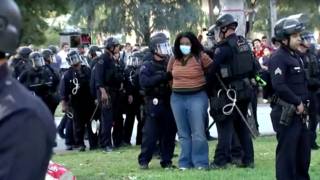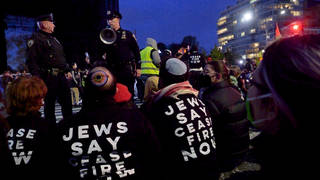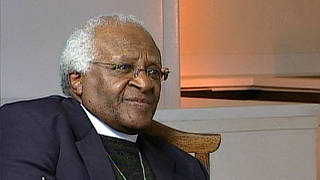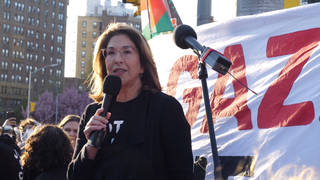
Related
Guests
- Ronnie Kasrilsleading anti-apartheid activist who was on the National Executive Committee of the African National Congress for 20 years. He also served as minister for intelligence services in post-apartheid South Africa from 2004 to 2008.
As thousands of mourners line up to pay their last respects to Nelson Mandela, we go to Johannesburg to speak with longtime anti-apartheid activist Ronnie Kasrils. A founder of the armed wing of the African National Congress, Kasrils worked closely with Mandela after first meeting him in 1962. Kasrils was a leading anti-apartheid underground activist, and on the National Executive Committee of the African National Congress from 1987 to 2007. He was also a member of the Central Committee of the South African Communist Party from December 1986 to 2007. Kasrils served as minister for intelligence in post-apartheid South Africa from 2004 to 2008. His late wife, Eleanor, was a Scottish-South African anti-apartheid activist, whose story he recalled in his 2011 book, “The Unlikely Secret Agent.” His autobiography is “Armed and Dangerous: My Undercover Struggle Against Apartheid.”
Click here to watch part 2 of this interview.
Transcript
JUAN GONZÁLEZ: The mood in South Africa has turned solemn after Tuesday’s memorial for the late president and anti-apartheid leader, Nelson Mandela. Mandela will lie in state through Friday in an open coffin in the capital of Pretoria. His body is on view in the exact spot where he was sworn in as the country’s first black and democratically elected president 19 years ago. South African police say the line of people waiting to pay their respects stretched nearly four miles long, reminding many of the lines on election day in 1994. Earlier Wednesday, a motorcade transported Mandela’s coffin from a military hospital to be displayed, passing the courthouse where he was sentenced to life in prison.
AMY GOODMAN: Among the first to pay their respects were family members and government officials, including Mandela’s former wife, Winnie Mandela, former President F.W. de Klerk, who freed Mandela in 1990 after 27 years in prison. The beloved leader’s head and shoulders were visible under a glass cover, his body dressed in a brown shirt. Many of the South Africans who came to see him said they felt closure after the viewing.
CANDY NSIRIZO: Today, it was: This is it. We are the first people to see him from the public, and we really confirmed that he is really gone, and he’s no longer with us.
JOHANNES THOMAS SEOKA: It was emotional, but very peaceful, emotions that arose within me. He’s lying there and carries a lot of peace around him. It was very moving. And it’s what I experienced.
MATILDA MATSAPOLA: My experience is like, you know what, at some point I never hoped to see him in that coffin, even one of the single day, but I guess that’s how it is, and then we should let go and let him rest in peace, you know. Yes, it’s bad. It’s emotional. But, yes, I guess he got his final destination. That’s where he is now.
AMY GOODMAN: For more, we go to South Africa, where we’re joined in Johannesburg by a man who worked closely with Mandela and first met him in 1962. Ronnie Kasrils was a leading anti-apartheid underground activist and on the National Executive Committee of the African National Congress for 20 years, from 1987 to 2007. He was also a member of the Central Committee of the South African Communist Party from December 1986 to 2007.
JUAN GONZÁLEZ: Kasrils served as minister for intelligence in post-apartheid South Africa from 2004 to 2008. His late wife Eleanor was a Scottish-South African anti-apartheid activist whose story he recalled in his 2011 book, The Unlikely Secret Agent. His autobiography is titled Armed and Dangerous: My Undercover Struggle Against Apartheid.
Ronnie Kasrils, welcome back to Democracy Now!
RONNIE KASRILS: Thank you.
JUAN GONZÁLEZ: Well, your thoughts, first, in terms of the passing of Nelson Mandela and his importance in—not only in your life, but of millions of South Africans and fighters for justice and freedom around the world?
RONNIE KASRILS: Well, in common with so many people close to him, as well as those who were far off, whether South Africans or internationally, profound sadness. Of course, he was 95 and ill for some time, so I can’t say it came as a surprise. In fact, we were prepared for this. But whenever death strikes, it seems to come like a thief in the night, and you’re shocked, and you’re torn up.
But actually, given the life he had led and the tremendous example of that extraordinary life of struggle, of being involved in a collective leadership all his life, of facing the death penalty, of all those years in prison, and then surmounting that and coming to a reconciliation with his enemies in terms of being able to acquire political power and set the country on the course of democracy, to have been close to him throughout all that obviously leaves a deep, deep pain and an extraordinary gap in one’s life.
But like a father—and I’m not using that term in a superficial way—when we say he was a father to us all, it was like the passing of one’s father, because this was a leader in the best sense of the world, a leader who led by example and led from the front, and could also lead from behind in terms of the way a shepherd makes sure the sheep are going in the right direction. So, one is actually filled with enormous strength at a very difficult and complex time.
Internationally, it’s a global problem and challenge that we all face, as well as very much in South Africa. One digs deep down, as many South Africans are now, for the lessons that must be learned. So, it’s been a huge period of continued reflection of his life, his example, and how we need to say farewell, but how we need to move forward on that long walk to freedom, which he says doesn’t come to an end, to be guided by the tremendous lessons of Nelson Rolihlahla Mandela’s times and his life.
AMY GOODMAN: Ronnie Kasrils, we have a good amount of time today to talk about the future of South Africa, as well, and the current president. But first we’d like to go back in time to the time you first met Nelson Mandela. Tell us when it was, where it was and what you both did together.
RONNIE KASRILS: Right. It was in July 1962. It was in a safe house in the city of Durban, a house that belonged to a worker, so it was rather small. The room that he was ushered into seemed to absolutely shrink in terms of the size of the man. He was far taller than I had ever expected, having seen him only through photographs and having heard of him, obviously.
But, you know, this is '62 I'm talking about, and I’d been in the movement for two years and in the armed wing of the ANC that he helped form, and that’s Umkhonto we Sizwe, or MK for short. So he was our commander-in-chief. And at the young age of 23, I found myself as part of the command of a province, the Natal province, now called KwaZulu-Natal.
And we weren’t expecting him. We knew it was an important meeting, but we didn’t know who we would be meeting. And there were many a leader; we weren’t short of leaders. And when he strode in, he was quite stern and grim, in terms of the times. A little bit of joking came in a little later on, but Mandela had just got back to South Africa, having slipped out and labeled the Black Pimpernel because he had gone underground the year before when he led a big strike, a national strike in May 1960 that was—May 1961, that was brutally put down by the police. And with Sharpeville and the way they put that strike down, these were part of the catalysts which brought about the end of nonviolent struggle and the formation of a new method of struggle and a new organization.
So he had been out of the country. He had been, as we came to learn later—and he let on a little bit about this in his discussions with us—for military training, that happened to be in Morocco. This was the base of the Algerian FLN at the time, where things were really coming to a head in that country. He had been to Ethiopia. He had met with African leaders. He had canvassed them about this new form of struggle in South Africa. And, I think famously, he had been to London in the houses of Parliament to spread the message and galvanize the anti-apartheid movement.
But his meeting with us was essentially to get reports from us about our work and how we were accomplishing our tasks, our mission, in terms of setting up underground cells in our province, one of four provinces of South Africa at that time, and the beginnings, just at the end of the previous year, so something like six, seven months previously, of our first sabotage actions, our first operations, which as leaders in our province we had participated in personally. And, of course, we were busy training other cadres of the underground, setting up the cells, setting up the machinery, preparing explosives. We were to, as a result of his arrest just a couple of weeks later, to actually, let me say, “liberate” rather than “steal” half a ton of dynamite from a road construction company, which meant that the actions of that sabotage phase of our struggle was on the point of really carrying some dramatic operations. The first operations were rather based on the kind of homemade, kitchen-type chemicals that people have read about in The Anarchist Cookbook or you learned a little bit about at school. But we were very, very serious and committed and believed that we would—we would really win, that this armed struggle would help to galvanize the oppressed people and fill the enormous gap left by the banning earlier of the Communist Party, but then, in 1960, of the ANC and the Pan-Africanist Congress.
And Mandela listened absolutely intently as we briefed him, possibly for a full hour. He showed no expression. It was just that very serious mask of a face. And when we finished, he put a number of questions to us and then gave us a briefing about what he had been doing outside the country and then discussed the tasks that lay ahead. It was then that there was a little bit of the jocular Mandela that appeared. I mean, this was like two hours without him smiling. We might have drunk a little bit of tea and water in that period. It was winter, but Durban can be rather clammy and hot. And he said to us, in that inimitable voice of his, “Boys,” he called us—I was the youngest; Billy Nair was there, and Curnick Ndlovu, Eric Mtshali, the other three members of the command, were probably 10 years or so, 15 years older than me. But he said, “Boys, you’ve got to train. You’ve got to be physically fit; in terms of the operations, painstaking, reconnoitering of an objective.” And he encouraged us to read as much as possible from international literature, from books like Hemingway’s Farewell to Arms about the Spanish Civil War to the Che Guevara material, Soviet partisans, the Cypriot struggle, and very importantly—I’ll never forget—the Mau Mau struggle, or the struggle of Kenyan Land Freedom Army. And he said to us, “Study African resistance. Know how the struggle in Africa, the armed struggle against colonialism in Africa, has been inspired and motivated, and its successes, its problems and its failures.” And, of course, that of the Algerian FLN was very much to the fore.
As a 23-year-old, Amy, I possibly wanted to show off. I was at university. I was something of an athlete, and I was in the cross-country club. And I said to him, “Oh”—we didn’t call him Madiba in those days, his clan name, that came much, much later. “Comrade Mandela, I’m training very hard with the running club.” And he said, “Oh, yes? And are you good at long distance? Because that’s what we need, my boy.” And I said, “Sure, and I’m going to train for the Comrades Marathon.” And he joked about how apt that particular term was for the race, which up 'til that time only whites could participate in. And he said to me, “You've got to train very, very hard.” And we joked a little bit about that, had tea. He left. And within, I think it was in just over a week, the dreadful, dreadful news arrived that Mandela had been arrested on that road from Durban to Johannesburg, a tremendous setback. So that’s something of that first event, that first occasion I met him.
AMY GOODMAN: Ronnie Kasrils, we have to break. When we come back, as you talk about what you and Mandela and the other leadership were doing in the ANC and the MK, what the conditions on the ground were. Now it’s referred to as the anti-apartheid movement, but what was apartheid, the reality on the ground? That arrest, also, with the help of the CIA locating Mandela and giving the information over to the African—the South African security forces. Ronnie Kasrils is with us for the hour in Johannesburg, leading anti-apartheid activist, on the National Executive Committee of the African National Congress for 20 years, served as minister of intelligence under Thabo Mbeki and was a top military official under President Nelson Mandela. Stay with us.
[break]
AMY GOODMAN: This is Democracy Now!, democracynow.org, The War and Peace Report. I’m Amy Goodman, with Juan González. Our guest for the hour is Ronnie Kasrils. He was former top military official under President Mandela, was in the ANC Executive Committee for 20 years, also served as the minister of intelligence under President Mbeki. I want to turn back to a rare televised interview; it was with Nelson Mandela when he was already in hiding. It was in 1961.
NELSON MANDELA: We have made it very clear in our policy that South Africa is a country of many races. There is room for all the various races in this country. There are many people who feel that it is useless and futile for us to continue talking peace and nonviolence against a government whose reply is only savage attacks on an unarmed and defenseless people.
AMY GOODMAN: That was Nelson Mandela in hiding in 1961. Ronnie Kasrils, can you talk about the conditions on the ground, why you, why Nelson Mandela and so many others got involved in the underground to fight apartheid, and also, as you mentioned his arrest, the role of the United States in that arrest, the role of an infiltrator in the CIA?
RONNIE KASRILS: Yes, well, of course, if you were of any color in South Africa other than pink, white pigmentation, any shade of color, which meant mixed race or people of fairly even light brown complexion, who were termed “coloreds,” right through to indigenous black people, or African people, as well as the Indian or Asian people from India who had been brought in under British rule to serve in the sugarcane plantations in the middle of the 19th century, and Malay people who had been brought in by the Dutch during their colonial period several centuries before, bringing in slave labor out of the Dutch East Indies, you had, with apartheid, out of colonial repression and exploitation, with the worst aspects of British rule in relation to that, tempered to some degree by the missionaries and their churches who had helped to provide a bit of education to a black elite, such as that which Mandela and others actually came from—you moved then to the 1948 period where apartheid proper was in power.
The National Party was elected to power—this was the Afrikaner extreme party—that then set about imposing very rigid race laws, scores and scores of them, regimenting people according to their color. If you were mixed race or Indian, you were second-class citizens; if you were black, you were absolutely third class. And this was segregation on a grand scale through the legislated laws of the country of the time, based to quite a degree on Nuremberg laws of race and race determination. And it was living in an absolute straitjacket in ghettos for the various people, in organized labor system, into the mines and the farms, where you served as absolute menial, almost slave labor for the most pitiful wages in the most dreadful conditions—with white South Africa, of course, living the life of privilege, from which I came.
So, in that sense, what motivated people, you were motivated by the oppression, the exploitation that you experience on a daily basis. And this was—and the indignities, the enormous indignities of color discrimination, which, of course, were hand-in-hand with class exploitation. But we should always bear in mind that the discrimination according to race and color, those are a thousand slats and cuts a day. That’s humiliation, and backed up by a police state to regiment people, to intimidate people, to deal with anybody who raised their voice, who put a foot wrong. So South Africa was living in that police state. And the motivation then, as referred to, was clear, but you had to be able to overcome your fear. You had to stand up and get onto your feet. Your conscience is what played that role, whoever you were, if you listened to it. And this was what drove the likes of Mandela and Sisulu and Govan Mbeki and Moses Kotane and all these other greats, the Albert Luthulis of South Africa.
If you were white like myself, you toed the line, and you enjoyed the privilege. You might wring your hands if you had a bit of a conscience, and you looked the other way. But there were a few of us, like the Helen Josephs and the Joe Slovos and the Ruth Firsts—names that you Americans know well—who couldn’t live with a conscience that basically would allow you to turn away. So, we were drawn in by this movement, which was repressed, which was underground. And if one was lucky or fortunate enough, like I happened to be through having a relative who had been in the Communist Party, when Sharpeville struck—and it shocked me, as it did so many others, to the core—I was able to determine that I would listen to my conscience, and I would follow those who led by example. And, you see, those two points, I would say, are crucial to Mandela and any leadership. People of conscience, people who lead by example, that pulled me in. And in no time, I was, as I’ve already indicated, very, very involved with clandestine activity and even part of the armed struggle. And I guess I progressed so swiftly because, as an athlete, as someone with particular skills and regarded as being a little adventuristic, and you need young people who are prepared to do things. There were many Indian, colored, black youth, like myself. I was lucky to be drawn in under Mandela and into that early Umkhonto we Sizwe, those early units.












Media Options